
Operating Manual and Installation Guide
Evolve® 200 mm Process Columns
Evolve® 250 mm Process Columns





Operating Manual and Installation Guide
Evolve® 200 mm Process Columns
Evolve® 250 mm Process Columns




Evolve ® Process Column s are designed specifically for use in b iopharmaceutical a pplications. The column s can be used in pilot or production scale c hromatographic processes.
A pressure rating of 4 bar, operating temperature range of 2-30 ºC, and adjustable bed height makes this column suitable for a wide range of chromatography media types and chromatographic techniques.
Design features
The entire flow path is non-metallic, which has the following advantages:
• Eliminates the risk of corrosion and process contamination
• Allows the use of high concentration sodium chloride solutions and Guanidine hydrochloride
• Prevents product inactivation through metal contact
Unlike other columns available on the market, Evolve® Process Columns have an integral bed support and seal assembly. The polypropylene mesh and seal are manufactured as a single unit and fit directly on the flow cell without any fixings, which has the following advantages:
• Ensure that maximum area is available to flow, promoting good chromatographic performance and cleanability
• Eliminates use of fixings to secure the bed support to the flow cell, removing the potential for leak paths or dead flow zones
• Reduces number of components in the column assembly, leading to easy operation and maintena nce
Sealing of the adjuster flowcell to the tube wall is achieved by a moulded Santoprene® seal. Central activation of this seal ensures that compression is even. The mechanism to energise and de-energise the seal is simple and easy to operate.
Positioning of the adjuster assembly within the tube is straightforward using the central adjustment mechanism.

The column is composed of three main sub-assemblies:
• Adjuster assembly - consisting of the adjuster flow cell assembly, adjuster seal components, adjuster flange and a central height adjust rod. This allows the position of the adjuster to be varied using the height adjust rods over the range 20-520 mm
• Tube unit – consisting of the column tube, flanges and column stand or support legs
• Fixed assembly – consisting of the bottom flow cell assembly and flow tube


*based on bed height of 520 mm and specific gravity 1.05
**minimum height required to remove adjuster from tube unit.

The pipework and column contribute to the pressure drop of the chromatographic system. Measuring the pressure drop from the column inlet to the column outlet shows the contribution made by the column hardware. The tests were performed at ambient temperature (15-20 ºC) using DI water.

All materials in contact with the process stream have been selected for their suitability for use in equipment utilised in biopharmaceutical applications, and so either conform to relevant sections of FDA code of Federal Regulations vol. 21 170-199 and/or have passed USP class VI tests for in vivo toxicity.
Materials of construction – process-wetted parts
Column Component Material
Column tube
Fixed flow tube
Adjuster flow tube
Acrylic
Polypropylene
Polypropylene
Sanitary clamp adaptors 20% Glass filled polypropylene
Bed supports
Polypropylene
Fixed Bed Support seal Santoprene®
Adjuster seal Santoprene®
Flow tube seal (fixed and adjuster) Santoprene®
Adjuster bed support seal Santoprene®
Fixed flow cell
Adjuster flow cell
Polypropylene (black)
Polypropylene (black)
Anti jet disc 20% Glass-filled polypropylene
Sanitary clamp seals Santoprene® elastomer
Pipe spool
Materials of construction – non-process-wetted parts
Polypropylene
Column Component Material
Adjuster flange, tube flange and fixed flange, fixed flow cell back plate (200 mm & 250 mm only)
Seal adjust boss, seal adjust tube
Threaded central adjust rod
Pipework clamp
Seal adjust handles (140 mm, 200 mm and 250 mm)
Lifting eye (200 mm and 250 mm only)
Support Leg
Foot (200 and 250mm only)
Bolts, screws, washers

Acetal Black
Stainless Steel
Acetal Black
Acetal Blue
Stainless Steel/ Acetal Blue
Stainless Steel 316
Stainless Steel 316
Stainless Steel with rubber pad
Stainless Steel type 316
Acrylic columns are ideally suited for aqueous-based applications. See the table below for detailed compatibility information.
Resistance Resistant; suitable for continuous use
Not resistant; not recommended
Limited resistance
No information available
Notes General All solvents are at 100% concentration unless noted otherwise
Concentrations: % refer to w/w
All data is referenced to room temperature (15º – 25ºC)
Chemical
1,2-dichloroethane
Acetic acid 25%
Acetone 5%
Acetonitrile
Ammonia aqueous <25%
Ammonium Sulphate 10-40%
Benzyl alcohol 1%
Benzyl alcohol 2%
Butanol
Calcium chloride 2
Calcium hydroxide 30%
Calcium hypochlorite
Chloroacetic acid 50%
Chloroform
Chromic acid 10%
Citric acid
Copper sulphate
Dichloromethane
Dimethyl formamide
Dimethyl sulfoxide 10%
Disodium phosphate
Ethanol 20%
Ethanol 70%
Ethylene glycol (1,2-ethanediol)
Formaldehyde 50%
Glycerol (Glycerine)

Chemical Compatibility cont.
Chemical
Guanidine hydrochloride 6 M
Hydrochloric acid 10%
Hydrofluoric acid
Hydrogen peroxide
Industrial methylated spirit (IMS)
Methanol 20%
Methanol 50%
Methyl chloride (Chloromethane)
Methyl ethyl ketone (MEK)
Methylene chloride
Nitric acid 10%
Nitric acid 70%
Peracetic acid 300 ppm
Phosphoric acid
Potassium hydroxide 2 M
Iso-propanol 20%
Iso-propanol 40%
n-propanol 20%
Sodium acetate
Sodium bicarbonate 20%
Sodium carbonate
Sodium chlorate
Sodium chloride 2 M
Sodium chloride 6 M
Sodium hydroxide 0.5 M
Sodium hydroxide 2 M
Sodium hypochlorite 200 ppm
Sodium nitrate
Sodium sulphate
Trichloroethene (Trichloroethylene)
Triton® X-100 surfactant
Urea 6 M
Zinc chloride

The following safety guidelines are presented.
European Pressure Directive 2014/68/EU relates to regulations that are mandatory and govern a wide range of pressure containing vessels. The design and manufacture of chromatography columns, including Evolve® Process Columns, are affected by these regulations.
The regulations are divided into categories, and Evolve® Process Columns have been assessed and found to fall within the Sound Engineering Practice (SEP) category. The foundation of the assessment is based on the following:
• The range of Evolve® Process Columns are liquid chromatography columns and when used in accordance with their o perating i nstructions there should be no gas (e.g., air) present in the columns
• The substances that will be used in the column will remain in liquid form during the entire operation at the maximum stated operating temperature.
In addition:
• The maximum operating pressure is greater than 0.5 bar and less than 10 bar
• The product pressure x volume is equal to or less than 200 bar litres
Users of these chromatography columns must ensure that the maximum operating pressure is not exceeded. It is recommended that an over-pressurization protection device such as a Pressure Relief Valve or equivalent is utilised.
Care should be taken when handling the columns. These columns and their subassemblies are particularly heavy.
Mechanical handling equipment or manual handling aids should be utilised to safely lift, move, or position the column or its subassemblies. This will avoid potential damage to the equipment and injury to personnel.
Provision is made for the use of a hoist, as lifting eyes are fitted to the top of the adjuster, and can be fitted to the top of the tube unit.
The lifting eyes are supplied to facilitate the safe lifting of the whole column, the adjuster assembly, or the tube unit.
It is essential that good practice is adopted regarding the use of appropriate slings and associated equipment, and to ensure the safety of personnel and prevent damage to equipment.
It is assumed that the user has available a hoist with hook and slings.

1. Ensure the rated capacity of the lifting equipment is sufficient to lift the column.
2. Ensure the lifting eyes are orientated in line with the slings. If they are not, there is a possibility of bending the eyes.

Figure 4: Orientation of lifting eye and lifting sling.
3. Ensure the shoulder of each lifting eye is in contact with the surface of the load (top plate) and the eye is securely fastened.

Figure 5: Correct location of eye nut on top plate of column or tube unit
4. Use only one sling leg to each lifting eye.
5. Do not fit the sling hook directly to the lifting eye – use a shackle.
6. Ensure the slings are sufficiently long. The included angle should not be more than 60º. Slings which are too short suffer excessive tensile load, which may lead to damage to the lifting eye or the sling. As a rule, ensure the slings are longer than the horizontal distance between the lifting eyes.
These instructions are intended to supplement users’ existing lifting practices rather than replace them and should not take precedence over Company or national standards.

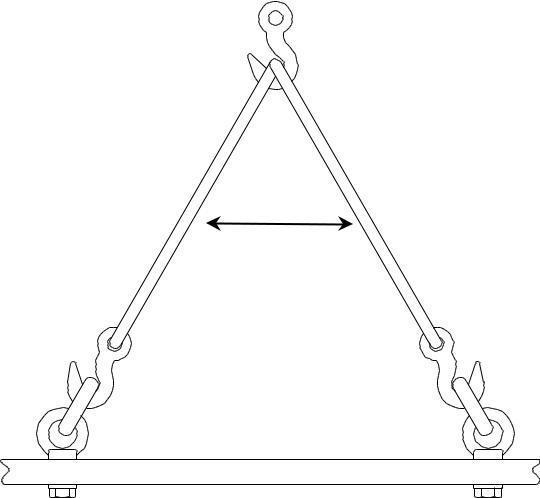
A potential pinch point exists between the adjuster assembly and tube flange.
Labelling highlights this issue, and operators should take care to ensure that when lowering the adjuster flange, operators are clear of this area. Further advice is given in the operation and maintenance section of the manual.

Care should be taken when handling the columns. Mechanical handling equipment or manual handling aids should be utilised where personnel cannot safely lift or move the column or its subassemblies.
Larger columns and their subassemblies are particularly heavy and will necessitate a twoperson lift, and the subsequent use of mechanical handling equipment or manual handling aids.
Provision is made for the use of a hoist. It is essential that good practice is adopted regarding the use of appropriate slings and associated equipment.
This manual lists those substances for which the columns are compatible. If substances not listed are to be used, the user must consider their effect as the integrity and safety of the column could be compromised.

The column is shipped preassembled. On receipt, it is recommended to check for damage or loosening of components during transit.
Complete instructions for disassembly and reassembly can be found in the maintenance section of the operating manual.
The following column preparation and installation procedures should be followed prior to operation:
• Install bed supports and flow path checks
• Level the column
• Set bed height
Installation of bed supports
Evolve® Process Columns feature polypropylene woven mesh bed supports, integrated with a Santoprene® seal. These do not require pre-wetting before use and are required to be fitted directly onto the adjuster and fixed flow cell.
All handling of bed supports should be performed by a user wearing gloves.
Installation of fixed bed s upport
1. Remove fixed flow cell from the column.
2. With the rough side facing towards the ribbed flow cell, press the edge of the seal into the location groove on the side of the flow cell. See Figures 7 and 8 shown below.


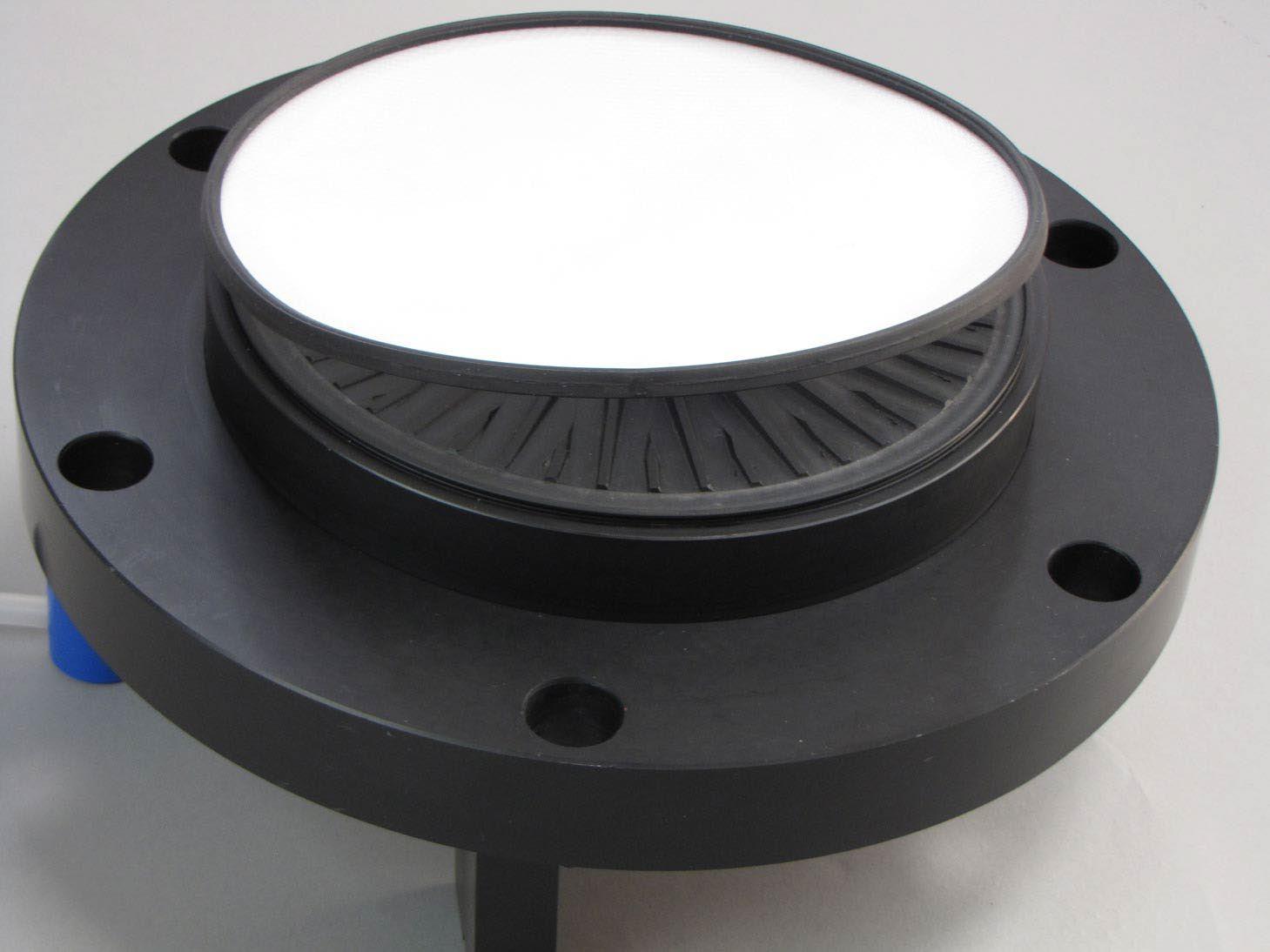
3. Locate fixed flow cell into the tube unit and fix in place.
Installing Height Adjustable Feet
The 200 mm and 250 mm columns are supplied with transportation casters. These assist with the removal of the columns from their packaging and enable the column to be located in the process area.
It is recommended that the casters are removed, and height adjustable foot pads are fitted.
To do this, the following procedure is recommended:
1. Remove the adjuster assembly from the column tube by removing the flange fixing bolts. Place the adjuster on a clean area.
2. Place the column on its side.
CAUTION: Column units are heavy.
3. Slide the sleeve upwards away from the caster unit.
4. Using the correct spanner, undo the caster assembly from the column support leg.
5. Fit the foot assembly and proceed to level the column.
Levelling the 200 mm & 250 mm Columns
200 mm and 250 mm columns are fitted with height adjustable feet and a spirit level is provided. This enables the column to be levelled or increase ground clearance.
For hygiene, the adjustability mechanism is covered by a sliding sleeve.

CAUTION: Before attempting to adjust the height of the support leg, carefully slacken the locknut located between the foot and the support leg. Please refer to Figure 9.
1. Slide sleeve upwards to gain access to adjuster nuts.
2. Using the correct spanner/wrench, loosen the locking nut. Fit a spanner to the height adjust nut and rotate the stud to raise or lower the caster. There is approximately 36 mm free vertical movement available in each foot; continuing to turn the screw beyond this point will detach the foot from the leg.
3. When the height has been adjusted, replace the sleeve.
Support Leg
Sleeve
Levelling Foot
Locking Nut
Locking Nut
Height Adjust Nut Height Adjust Nut
Figure 9: Height Adjustable Feet
Installation of adjuster bed support
A schematic of the adjuster assembly is shown in Figure 10 and a photograph (Figure 11) shows the adjuster assembly correctly assembled.
1. The adjuster assembly should be removed from the tube unit and placed on its side on a clean work surface.
2. With the rough side facing towards the ribbed flow cell, press the edge of the seal into the location groove on the side of the flow cell. See Figure 10:.
Seal Setting Ring
Figure 10: Diagram showing the location of the adjuster bed support.

3. Work around the circumference of the flow cell ensuring that the seal is correctly fitted. See Figure 11

11: Photograph showing the location of the adjuster bed support.
1. Reinstate the adjuster unit in the tube using the location pins and ensure the adjuster seal is de-energized.
2. Replace the flange fixing bolts underneath the tube flange and tighten.
3. Partially energize the seal and turn the height adjust handles clockwise to set the required bed height.
4. Check the column is level by placing the spirit level on the adjuster flange.

This section provides general guidance on operating Evolve® Process Columns. It includes a hydrostatic leak test to establish that the column is installed correctly and advice for the preparation of the chromatography media.
Further advice specific to each media can be obtained from the media manufacturers; this section only provides a general guidance.
The purpose of this test is to check that there are no leaks from the column and the column is ready to use. Due to the materials of fabrication, when the column is initially exposed to pressure the column will flex. It is necessary to perform the hydrostatic leak test using a twostep procedure.
1. Ensure fixed end is correctly located and fixings tightened to the correct torque setting.
2. Fill the column with WFI or high-quality water and position the adjuster at the operating bed height.
3. Ensure the adjuster seal is wetted with buffer or other suitable liquid prior to assembly. This helps lubricate the seal to ensure correct seating.
4. Activate the adjuster seal.
5. Ensure all air is removed from the column and any connections.
6. Attach a calibrated pressure gauge to the top inlet of the column.
7. Raise the column pressure until 3 bar (45 psi) and close bottom inlet valve. Wait 15 minutes for the pressure to stabilize.
8. Open the valve and increase the pressure to maximum working pressure 4 bar (58 psi).
9. Wait 15 minutes for the pressure to stabilize. Check the pressure and ensure pressure is 4 bar (58 psi).
10. Wait for a further 15 minutes.
Due the nature of materials it is likely there will be a small pressure drop; however, this should not exceed 0.1 bar.

Below provides a general method for preparing and packing Evolve® Process Columns. However, it is advisable to follow the media manufacturer’s recommendation for preparation of the media.
1. The media should be prepared as a 50 – 75% slurry in equilibration buffer, packing buffer or other suitable solvent.
2. Media that contains a high level of fines will benefit from a de-fining step prior to packing. Suspend the media in a suitable solvent and allow settling to occur. Gently decant the supernatant containing the fines and discard.
1. To identify the column components, see the schematics in this subsection.
2. Attach a valve to the fixed end pipe spool.
3. Remove the adjuster assembly.
4. Fill the fixed cell with buffer until approximately 20 mm depth of buffer is seen in the column tube. Either pump buffer into the cell via the pipe spool, or pour buffer carefully into the column, ensuring the liquid runs down the side of the tube to avoid creation of air bubbles.
5. Ensure the valve at the fixed end is closed.
6. Ensure the slurry is thoroughly mixed by using gentle agitation
7. Carefully pour the slurry into the column. Avoid trapping air bubbles in the slurry as it is poured.
8. Fill to a maximum of 30 mm from the top of the tube.
9. Rinse the top inside surface of the column tube to prevent media from becoming trapped between the adjuster seal and the tube.
10. Replace the adjuster assembly back into the column tube and secure to the tube flange using the flange fixing bolts.
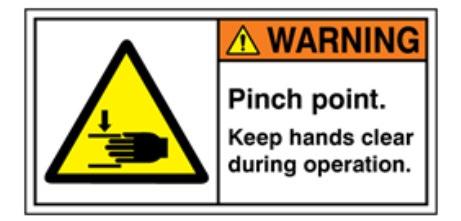
11. Ensure the adjuster cell assembly is approximately 30 mm from the slurry mixture.

12. Attach a flexible tube to the adjuster flow tube; this tube will be used to drain excess buffer during packing.
13. Continue to lower the adjuster flow cell toward the slurry by turning the height adjust handles, but do not enter the slurry mixture.
14. The slurry will start to settle; when a liquid interface is seen, gently lower the adjuster into the slurry. Set the adjuster seal using the seal actuation nut. At this stage the seal only needs to be just energized so that further lowering results in buffer being forced out of the flexible tube attached to the flow tube. The adjuster unit will now be located in clear buffer and packing of the media can start.
15. Fully energized the adjuster seal by further turning of the seal actuation nut.
16. Ensuring that no air is introduced into the line, connect a pump and source of equilibration buffer to the flexible tube.

17. Pump buffer into the column at an appropriate rate to pack the bed. Ensure the fixed end valve is open. The packing flowrate should be higher than the highest flowrate to be used during the process. Note that some media will pack more efficiently at flowrates considerably higher than the final running flowrate; consult the media manufacturer for recommendations. Ensure that the maximum operating pressure of the column is not exceeded, especially since the back pressure will increase as the bed packs.
18. When the bed has stabilized, stop the pump and direct the flexible tube to drain.
19. To lower the adjuster, gently release some of the seal compression, and turn the height adjust handles clockwise. Buffer will eject from the flexible tube; continue until the bed support touches the top of the packed bed.
20. If the media is compressible, the packed bed may expand while the adjuster is being lowered, and it may prove necessary to repeat steps 15 to 19 above.
21. When the final bed height has been reached, turn the seal actuation nut to apply maximum seal compression.
22. After the final compression step, flow in the upwards direction to remove any residual air at the top of the column.
NOTE: It is advised to provide additional support if large valves or stainless-steel pipework is connected to the top flow adaptor.
CAUTION: Do not adjust the seal actuation nut when the column is under pressure.

The column may be unpacked conventionally. The adjuster can be removed, the bed reslurried, and the media poured or pumped out of the column tube.
Cleaning
NOTE: Do not use abrasive cleaning materials or pads, as these may score plastic components
The extensive solvent and chemical resistance of the column components allows the use of a wide range of clean in place (CIP) solutions, including:
• Sodium hydroxide (0.5 M - 1.0 M)
• Sodium hydroxide (0.1 M) + ethanol (20%)
• Peracetic acid (300 ppm)
For thorough cleaning after use the column should be dismantled into its component parts, thoroughly washed with detergent, and rinsed thoroughly with deionized water. The column should then be dried prior to storage.
Storage
For in-process storage the packed column may be stored in any compatible solvent; refer to the Chemical Compatibility table in the Installation section. Choice of a particular solvent will usually be dictated by the chromatographic media; refer to media manufacturers data for this. Common storage solutions are 0.1 - 0.5 M sodium hydroxide or 0.1 M sodium hydroxide + 20% ethanol, both of which are suitable for long term (several months) storage with Evolve® Process Columns.
Unpacked columns should be kept in a cool, dry, dust -free location and protected from light. Do not expose acrylic column tubes to direct sunlight for prolonged periods or sterilize with ultra-violet lights as this may reduce the mechanical strength of the tube.

To disassemble and assemble the columns follow the instructions below. After reassembling the column ensure that the column does not leak by performing a hydrostatic leakage test.
When assembling/dissembling attention should be paid to:
1. Always use the correct size tools. A comprehensive tool kit is provided with the columns. See table below.
2. Ideally components should be at approximately room temperature (approximately 20 °C). If not, take particular care as thermal expansion or contraction may make components fit more tightly and thus more difficult to disassemble.
3. Dismantled assemblies should be rested on a clean, dry surface.
4. Pay particular care not to damage the edge of the flow cells.
5. When unpacking columns be careful not to scratch the inside of the column tubes
6. Be careful not to damage stainless steel surfaces by bumping, knocking or scratching.
7. Do not over-tighten components and use correct torque settings as given in this guide.
8. Good engineering practices should be followed at all times and operations carried out in an approved and safe manner.
Key Set
Allen Key Adaptor
Flange Fixing Bolts
Spanner 13 mm / 17 mm open ended 13 mm spanner - column flow tube connection on adjuster flow cell 17 mm spanner – flow tube on fixed flow cell
Spanner 22 mm / 24 mm
Fixed End Tool - Large
Torque Wrench 3/8" Drive
Spirit Level
Micro S/Driver Slotted 1.2 mm

Adjuster Feet
Used with torque wrench on fixed end cell fixing nuts
Used to set correct torque on fixed end fixing nuts
Used to level the column
To assist removal of bed support seal assembly
Adjuster Assembly
1. Remove flange fixing bolts that are located underneath the top column tube flange.
2. Check that adjuster seal is released by turning the seal actuation nut counterclockwise.
3. Lift adjuster unit out of tube unit and lay it on its side on a clean workspace.
CAUTION Adjuster units are heavy and will roll if not secured.
4. Remove flow tube adaptor and retain flow tube seal.
5. Remove the seal adjust nut and spacer and slide the flow tube and seal adjust tube out of the threaded rod.
6. Remove the flow cell locking clip and retain. Slide the stainless steel tube off the flow tube.
7. Locate the flats on the flow tube and, using the correct sized spanner, remove the flow tube to expose the flow tube seal.
8. The adjuster bed support can be removed from the adjuster cell by carefully prizing the bed support seal from its location groove in the side of the adjuster cell. A small extraction tool is provided. N.B. Care must be taken not to damage the seal or the flow cell.

Fixed Assembly
1. Identify the components on the schematic shown in Figure 14.

2. Disconnect the pipework from the bottom of the column.
3. Identify the fixed end support blocks that are located on the column support legs. Swing these blocks so that they support the flow cell. These will support the flow cell when the fixing bolts are removed. See Figure 15.
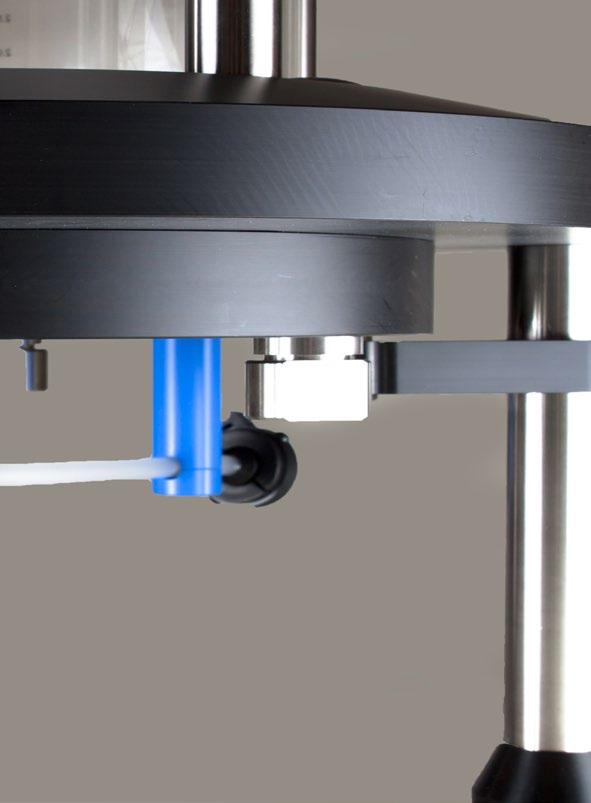
15: Photograph showing position of the support blocks before the fixing bolts are completely removed
4. Using the fixed end fixing tool and torque wrench, loosen each of the fixing bolts. Remove the flow cell and place it on a clean work surface.
5. Locate the flats on the process flow tube and using the correct tool remove the flow tube. Retain and inspect the flow tube seal.
6. To remove the seal assembly from the flow cell carefully prize the bed support seal from the flow cell.
Tube assembly
The unit should only be disassembled as part of an emergency repair procedure. Details of the method will be provided with the replacement parts.

Reassembly of the column is the reverse of disassembly.
Fixed Assembly
1. Install the process flow tube into the back of the flow cell. Ensure the flow tube seal is located. Tighten process flow tube using correct tools.
2. Install the bed support assembly on to the flow cell by carefully locating the bed support seal onto the flow cell. The bed support should be fitted with the smooth side facing into the column. See Figure 16 below.
3. Fit all the process pipework and ensure all connections are secure but do not overtighten.
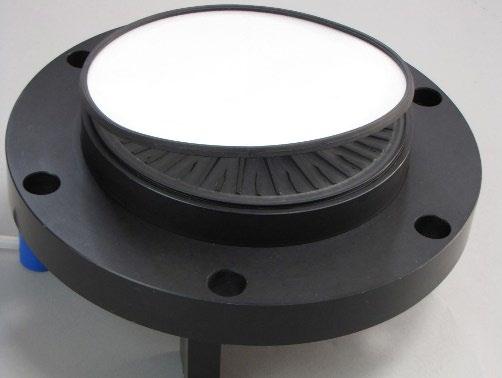

4. Ensure the support blocks are turned outwards to allow the flow cell to be located. See Figure 18 below.

Figure 18: Photograph showing position of fixed end support blocks to enable relocation of the flow cell
5. Support the flow cell with your hand and turn the support blocks inwards to support the flow cell. Initially, hand tighten the bolts, working diametrically opposite to ensure equal loading on the seal. Then using the fixed end fixing tool and torque wrench, tighten the bolts to the torque settings shown in the table below.
6. Fit the pipework elbow and ensure all connections are secure. Do not overtighten.

At the start of the procedure the adjuster assembly is partly assembled and consists of seal setting ring, seal adjust tube and adjuster flange.
1. Install the adjuster bed support by carefully locating the bed support seal into its location groove in the side of the adjuster cell. Ensure the seal is pushed tight into the groove. The bed support should be fitted with the smooth side facing into the column, rougher side to flow cell. See Figure 19 below.
Seal Setting Ring
Figure 19: Diagram showing the location of the adjuster bed support
2. Push the adjuster seal onto the seal setting ring. Ensure that the seal is correctly located by checking it is located in the groove in the setting ring.
3. Fit the flow tube seal into the adjuster flow cell and replace the flow tube. Use the correctly sized spanner to tighten.
4. Locate the flow tube within the stainless steel central seal setting tube and replace the flow cell clip.
5. Locate the flow tube unit inside the threaded adjuster height tube.
6. Replace the spacer and central seal adjust nut and engage the thread.
7. Refit the flow tube seal and ladish adaptor.
8. Lift adjuster unit into the column tube. Alignment pins are located in the top flange to assist orientation.
CAUTION: Adjuster units are heavy.


9. Refit the flange fixing bolts and tighten the bolts with the Allen/hex key adaptor.
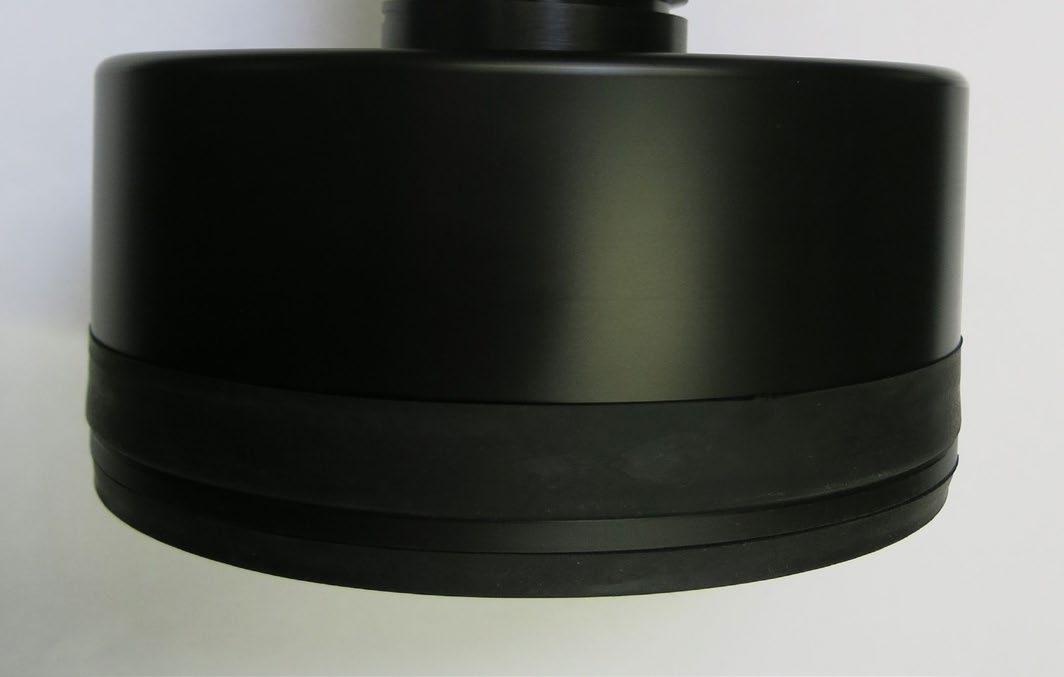
Photograph showing the location of the adjuster bed support
10. Replace the flow tube adaptor. To ensure the fitting is tightened correctly, align the markings on the flow tube and adaptor. As shown in Figure 21. Initially hand tighten and then use correct size spanner. Do not over tighten.
CAUTION: Over tightening this adaptor can lead to failure of this component.


Refer to the maintenance section before undertaking any procedure advised below.
Excessive column back pressure
When troubleshooting pressure increases or sudden decreases ensure that pressure readings are always taken at the same location so that accurate comparison can be made. There are numerous factors that can cause excessive back pressure in chromatography, such as problems with the chromatography system (e.g., partial valve failure), issues with the media packed bed (e.g., over compression, consolidation, or bed fouling), the process fluid, or problems with the column. Sudden decreases can result from bed collapse or cracking, flow instability or pumping issues. This troubleshooting guide focuses solely on issues related to the column.
Possible Cause
Bed support blockages
Restrictions to inlet/outlet pipework
Incorrect seal size used to connect pipework
Suggested Actions
Unpack and empty the column, run a pressure drop test over a range of flowrates and compare with pressure/flow curves in manual. If blockage due to viscous feed streams or media containing fines, replace bed supports
Ensure correct connections and diameter of pipework used
Ensure correct pipework seals used
Post column valve blockages Ensure valves fitted to column are correct functioning
Loss of pressure
Possible Cause
Column leakage/ seal failure
Suggested Actions
Identify cause and use advice above on leakage issues and replace parts if required
Bed support integrity lost Replace bed supports
Media leakage
Possible Cause
Media, or high concentration of media fines, not suitable for pore size of bed support
Incorrect bottom flow cell positioning and/or tightening
Damage to bottom or top bed support and any bed support seals
Failure of adjuster seal
Suggested Actions
Check particle size distribution of media and ensure a defining process has been performed before use
Unpack column and check installation of bottom flow cell and seals. Reassembly correctly using guidance in operating manual or refresh kit guide
Replace bed supports or seals as required
Check seal for damage or misalignment. Reassemble or replace as required

Care should be taken not to introduce air into the column by ensuring bubble traps are used upstream of the column, media is not vigorously stirred, all connections are primed before being made, and all buffers are degassed
Possible Cause
Air inclusion occurs during flow packing but before adjuster lowered
Air inclusion after packed bed formed
Leakage from adjuster seal
Possible Cause
Damaged adjuster seal
Foreign material or media trapped between seal and sealing faces on column tube, flow cell or seal setting ring
Seal not energized sufficiently
Seal not correctly attached to seal adjust ring
Suggested Actions
Release adjuster seal slowly and allow air to pass adjuster seal Lower adjuster with top process port open with no restriction
Flow in reverse direction until air is removed or any dry patches become wetted. Always requalify the packed bed after this procedure
Suggested Actions
Remove seal and inspect Replace seal if damaged
Clean and inspect seal and reseat seal
Try relaxing and re-energizing the seal
Do not adjust seal actuation handle when Column is under pressure
Ensure seal fitted to the seal seating ring on outside and inside surface
Leakage from inlet/outlet of the column
Possible Cause
Incorrect installation of flow tubes and flow tube seals
damage or over-compression of flow tube seals or flow tube adaptor seals
Damage to flow tube adaptor or pipespool from using incorrect clamp or excessive clamp force
Suggested Actions
Use operating manual or refresh kit manual to assemble correctly
Replace any damaged components
Replace any damaged components. Ensure plastic clamps are used as metal plastic can be over tightened and can cause damage
Leakage from bottom of the column
Possible Cause
Bottom flow cell incorrectly assembled
Bed support assembly damaged or incorrectly assembled
Flow cell fixing bolts loose
Suggested Actions
Check fixed end fixings with a torque wrench for correct torque setting
Remove bottom flow cell and inspect bed support. Replace if damaged or any crush points observed
Use guidance in operating manual to fit bottom bed support correctly
Retighten all bolts if operating under cold room conditions or with cold process fluids. Use diametrically opposite pattern for tightening
Refer to the maintenance section before undertaking any procedure advised below.

The following kits are supplied with the column:
• Connection Kit
• Spares Kit
• Tool Kit, including torque wrench.
It is possible to re-order these kits using the product codes listed in the table below.






To view our Evolve® Process Column User guides please visit: https://www.astreabioseparations.com/resources/hardware- user-guides
For further enquires please contact: sales@astrea-bio.com

To determine chromatographic efficiency of a packed chromatography column, it is usual practice to inject a small analytical sample onto the column and monitor the response at the outlet.
Typical solutions used include an acetone or a NaCl solution. If acetone solution is used, the UV absorbance is measured and plotted. If a NaCl solution is used, then conductivity is measured and plotted.
The plot obtained is then analysed to calculate the following terms of efficiency.
Chromatographic efficiency is most often expressed as HETP (height equivalent to theoretical plate) and Asymmetry. These are calculated directly from the UV plot as shown below.
Calculation of HETP: HETP = N L
Where L is the column height in mm
Where N is the number of theoretical plates
Calculation of theoretical plates (N):


Asymmetry is measured at 10% of the peak height and is calculated according to the equation shown below, where a and b relate to the width of the peak as shown in Figure 1.
Asymmetry =
Two further calculations which can be performed to describe column efficiency are reduced plate height (RPH) and dilution factor.
Reduced plate height considers the particle size of the media and enables comparison between different media types. A low value of RPH denotes good column efficiency; a RPH of less than 6 is expected.
RPH =
Where Pd is the mean particle diameter.
Dilution factor includes the initial sample volume in the calculation. This allows comparison between different peak shapes. The dilution factor is given by the following equation.
volume sample Initial ba factor Dilution + =
Where the initial sample volume and the values of a and b are all expressed in the same volume units.
Different media manufacturers often express performance in terms of the definitions above. Caution must be taken when interpreting and comparing performance results. It is advised to check not only the media type used but also the flowrate, column diameter and bed height. Often results are given for tests performed in laboratory scale columns.

Revision
A Initial release 30/09/2014
B Photographs updated 25/02/2015
C Address updated 18/06/2018
D Pressure Equipment Directive reference updated 06/04/2021
E Technical specification updated – Casters not available on 70-140mm columns 22/04/2021
F Updated to reflect Evolve® Trademark status 12/07/2021
G Updated Safety Instructions and Guidelines 01/02/2022
H Rebrand & Troubleshooting Guide revised 05/04/2024 Manual Revision

